 (01)
(01) Country’s full name: The Republic of Poland
 (01)
(01)
National flag : Color: top - white, bottom – red
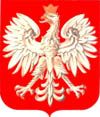 (02)
(02)
National emblem : White eagle in a crown against a red background
National anthem : "Dabrowski's Mazurka" ("Mazurek Dabrowskiego")- originally a patriotic soldiers' song; the text by Jozef Wybicki
http://freepages.genealogy.rootsweb.com/~atpc/heritage/history/anthem-pl.html
Map of Poland (03)
Poland is situated at the very heart of Central Europe sharing borders with Russia in the north; Lithuania, Belarus and Ukraine in the east; the Czech Republic and Slovakia in the south and Germany in the west. To the north, Poland is bordered by the Baltic Sea with an easy access to Scandinavian and North Sea ports and to the south, by the Sudeten Mountains (Sudety) and the Carpathian Mountains (Karpaty). Poland’s side borders are marked by the Oder (Odra) and Neisse (Nysa) rivers in the west and the Bug River in the east. The maximum distance from east to west is about 689 km, whereas the maximum distance from north to south is about 649 km. The country occupies an area of 312,685 square km, which makes it the ninth largest country in Europe and the 69th largest in the world. Warsaw is Poland's capital and the largest city located near the geometrical center of the country.
The surface of the country can be divided principally into the lowlands, the uplands, and the mountains; however, the lowlands, which are part of the North European Plain, cover as much as 91 % of its territory; therefore, an average height is 173m above sea level. That is why, Poland seems to be an unbroken plain spreading from the Baltic Sea to the uplands and the mountains in the south with the highest elevation of Rysy ( 2,499 m) in the High Tatra range. The plains are threaded by several large rivers, such as the Vistula ( 1047 km), the Oder (Odra) ( 854 km), the Warta ( 808 km), the Bug ( 772 km), the Narew ( 484 km), the San ( 443 km), the Notec ( 388 km), the Pilica ( 319 km), the Wieprz ( 303 km) and the Bobr ( 272 km). Poland also contains over 9,300 lakes, predominantly in the north of the country; however, many scenic lakes are also hidden in the mountains. The largest one is Lake Sniardwy ( 11,383 ha) in the Masurian Lake District, and the deepest is Lake Hancza ( 108.5 m). There are three main mountain ranges in Poland: the Carpathians (Kapaty), the Sudeten Mountains (Sudety), and the Holy Cross Mountains (Gory Swietokrzyskie). The highest-lying settlement is Gubalowka ( 1125 m above sea level) in the Tatra Mountains (Tatry), while the lowest-lying is the village of Raczki Elblaskie ( 1.8 m below sea level) at the seaside.
Map of geographical regions of the country (04)
The characteristic feature of Poland’s relief is the division into a number of distinct parallel regions, which extend horizontally. In the very north there is a wide strip of plains of various width along the Baltic Coast, stretching from Germany to Kaliningrad region in Russia. It is mainly occupied by the general region of Pomerania (Pomorze), which comprises smaller subdivisions. In this area numerous types of seaside landscapes may be found, such as dunes, deltas, lakes and bogs as well as seaside cliffs. Moreover, the region includes pre-valleys, lying 100 m below sea level. The coastline is rather smooth and regular; nevertheless, it has two major bays: the Pomeranian (Pomorska) Bay in the west and the Gulf of Gdansk in the east. The former cuts two major Polish islands Wolin and Uznam off the Szczecin Lagoon, into which the Oder river flows. With the latter, in turn, the Vistula (Wisla) river connects, forming a large delta, on the outstanding sandbars of which, the winds have raised
large dunes, blocking off the coastal lakes and lagoons from the sea. The main urban centres of this region are the ports of Szczecin, Gdansk, Gdynia and a seaside resort Sopot.
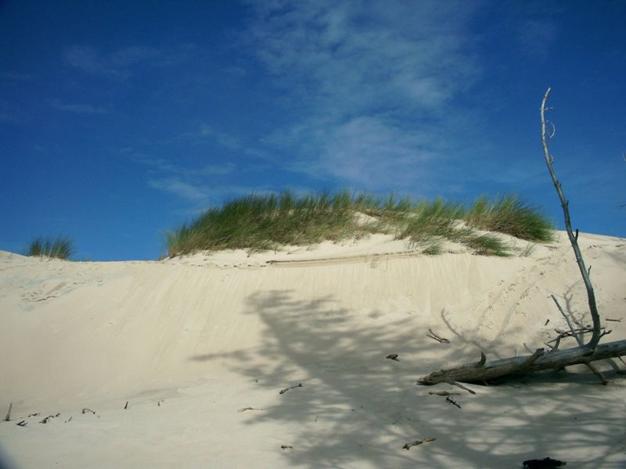
Slowinski National Park (05)
Photo: www.poland.gov.pl
Just to the south of the coastal plains extends the Lakeland region, famous for its numerous post-glacial lakes and a varied hilly landscape. Wide shallow river valleys split this region into three main parts: the Pomeranian Lakeland (Pojezierze Pomorskie), the Masurian Lakeland (Pojezierze Mazurskie), and the Great Poland Lakeland (Pojezierze Wielkopolskie).
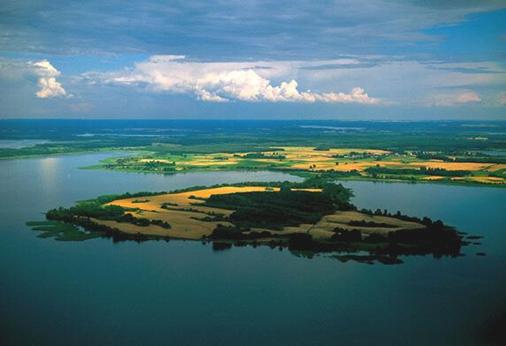
Masurian Lake (06)
Photo: GA, www.poland.gov.pl
The middle part of Poland is covered by the region of the central lowlands, which is generally flat and monotonous. The basins of the main rivers divide the area into the Silesian Plain (Nizina Slaska), which lies in the upper Oder river; the southern Great Poland Plain (Nizina Wielkopolska), which lies in the middle Warta basin, the Mazovian Plain (Nizina Mazowiecka) and the Podlasian Plain (Nizina Podlaska), which lie in the middle Vistula basin.
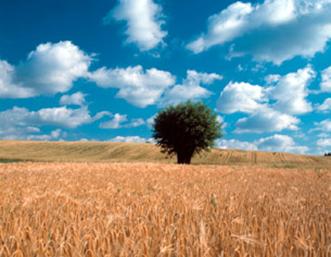
A Greater Polish rural landscape (07)
Photo: J. Morek/FORUM source:poland.gov.pl
To the south of this vast flat area, the terrain reaches some height to form the region of Poland’s Uplands to the east, and the region of the Sudeten Mountains (Sudety) with its Sudeten Foreland (Przedgorze Sudeckie) to the west. This area, consisting of hills, low mountains and plateaus, is densely populated because it contains much of Poland’s mineral wealth and the richest farmland. The uplands of Lesser Poland, which are folded diagonally, include the Silesian upthrust with rich deposits of coal, the Cracow and Czestochowa Jura with its unique flora and Jurassic limestone rocks, Nida Trough (Niecka Nidzianska) with its richest soil, then the Kielecko-Sandomierska Upland with its upthrust of the old rocks shaping the Holy Cross Mountains (Gory Swietokrzyskie) and the Lublin Upland (Wyzyna Lubelska) with Roztocze in the very east.
The Sudeten Mountains (Sudety) and its foreland (Przedgorze Sudeckie) are part of the larger Bohemian Massif. Their highest range, the Karkonosze, reaches 1602 m above sea level (Sniezka). The lower ranges include the Table Mountains (Gory Stolowe) with their bizarre rock forms as well as the extensive, lush Orlickie and Bialskie Mountains (Gory Orlickie and Gory Bialskie). The region shelters many serene resorts and spas.
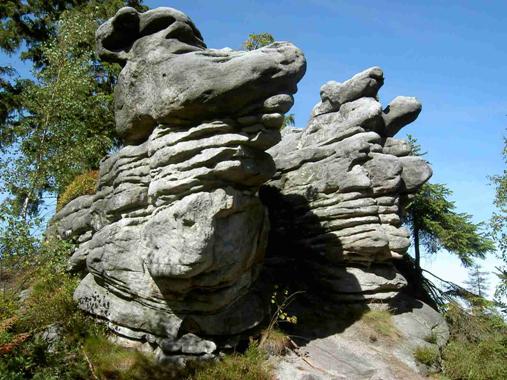
The Table Mountains (08)
Photo: P. Fabijański
www.poland.gov.pl
In the very south of the country lies the Sub-Carpathian region with their valleys: Oswiecim Valley (Kotlina Oswiecimska), Sandomierz Valley (Kotlina Sandomierska) and then young mountains- the Carpathian Mountains (Karpaty) with their linked chains and basins. The highest range is the Tatra Mountains (Tatry) with the highest peak Rysy of 2,499 metres, divided into the High and the Western Tatras. The former boast an abundance of tarns, while the latter hide the most beautiful caves. The lower ranges within the Polish Carpathians include the Pieniny, the Beskid Mountains and the Bieszczady in the east. What is characteristic about the Bieszczady is the low run of the forest border (about 1 200 – 1 220 m) and wide meadows called “poloniny” that decide about that range uniqueness. Their highest summit is Tarnica ( 1 346 m high).
The Tatras (09)
Poland lies in the area of a transitional climate due to the influences of the oceanic currents from west, the cold currents from Scandinavia and Russia and warm and wet ones coming from the Mediterranean sea, which are greater than the former (46% to 38%). This results in distinguishing six different seasons and half-seasons as well as the great changeability in the weather patterns; that is why, the climate can significantly vary every year. Winters can be sometimes mild or sometimes cold, in the same way, the summers can be either cool and rainy or hot and dry. The early springs tend to be dramatic because of the floods, supplied by the melting snow. The dry and subtropical continental masses of air bring pleasant temperatures at the end of the summer and the beginning of the autumn. In November begins the transition into winter - a period of rainy, colder late autumn weather. The longest growing season is in the southwest, whereas the shortest one is in the northeast.
The spatial distribution of air temperatures and precipitations in Poland depends especially on the altitude and the distance from the Baltic Sea. The average temperature of the year is 9°C in the southwest, 6°C in the northeast and 4°C in the mountains. The coldest month is January with average temperatures ranging between -5 °C and -1,5 °C and the warmest is July with average temperatures from 17 to 19 °C. The last ground frosts occur in Poland around May 15 th and the first ones may be expected in the second decade of October. Average annual precipitation for the whole country is 600 millimeters, but isolated mountain locations receive as much as 1,300 millimeters per year.
AVERAGE TEMPERATURE |
°C |
WARSAW |
|
||
JANUARY |
-3 |
|
|
||
FEBRUARY |
-3 |
|
|
||
MARCH |
2 |
|
|
||
APRIL |
8 |
|
|
||
MAY |
13 |
|
|
||
JUNE |
17 |
|
|
||
JULY |
19 |
|
|
||
AUGUST |
18 |
|
|
||
SEPTEMBER |
14 |
|
|
||
OCTOBER |
8 |
|
|
||
NOVEMBER |
3 |
|
|
||
DECEMBER |
-1 |
|
|
||
source: http://www.eurometeo.com/english/climate/city_EPWA/meteo_Warsaw
The chart of monthly average temperature in the capital
(10)
Poland has proven very attractive as a travelers’ destination. Its splendor can be admired in both its old cities hiding historic treasure and in the wild scenery of Polish nature reserves. Each country’s region has something to offer.
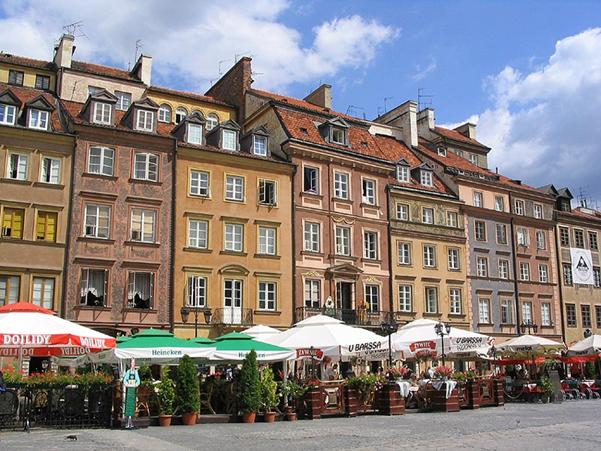
Warsaw 's Old City, Photo: J. Lamparski, www.poland.gov.pl (11)
Warsaw , the capital and Poland’s largest city, plays the prominent economic, cultural and educational role in the country. Although it was almost completely destroyed during World War II, it followed a massive and thorough reconstruction to restore the grandeur of many monuments to life. Thus the city can boast of Old Town (Stare Miasto), which was authentically renovated. Apart from over 20 museums one can admire Zamek Krolewski, the reconstructed Royal Castle; The Wilanow Palace with a spectacular collection of old paintings and furniture; the massive post communist Palace of Culture and Science with a wonderful view of the whole city, The Lazienki Palace, a lovely park with an open-air Greek
theatre and many others. Nature enthusiasts can visit the nearby Kampinos National Park, where it is possible to see the wild boar and the elk.
In the north lies Pomerania (Pomorze), a region with a well-developed tourist base. The area is well known with holidaymakers for its landscape diversity, consisting of beaches, lakes, hills, numerous rivers and forests as well as the grandeur of its cities. In the past, there was an amber route crossing over here followed by Roman merchants. The Baltic Coast offers sandy beaches for most of its length and many interesting places e.g. Swinoujscie, Miedzyzdroje, Kamien Pomorski, and Kolobrzeg, each of them being a renowned spa. Kolobrzeg is the biggest and best-known spa boasting its dozens brine springs. The Slowinski National Park, an exotic natural attraction with 44-metre tall movable sand dunes at the banks of Lake Lebsko, is an important biosphere reserve and a haven for rare bird species.
The capital of Eastern Pomerania is Gdansk, one of Poland's three major seaports, a marvelous city with a thousand years of history and plenty of priceless monuments. With Sopot- a resort best known for its wide wooden pier and the Open-air Opera Hall ( Opera Lesna) and a classic seaport of Gdynia , Gdansk makes up a metropolis known as the Triple City (Trojmiasto). More to the east the Hel Peninsula stretches, marked with quiet and pleasant seaside resorts: Jurata, Jastarnia, Chalupy, and Hel, all with clean, wide beaches sheltered by dunes and pine groves. The Pomeranian Lakeland region includes two lake districts, the Kashubian and Drawa Lake Districts, and the vast areas of the Tuchola Forest, which are some of the biggest natural and tourist treasures in Poland, easily accessible and gorgeous. The Kashubian vicinity is inhabited by Kashubi, an interesting nation, which maintains its cultural identity, has own language, customs and even literature and occupies itself with fishing. In Malbork (Marienburg) there is the biggest in Europe Teutonic medieval brick castle built originally in the 13 th century. Some other mediaeval-style elements may be found also in Gdansk, Pelplin, Kwidzyn, Tczew, Slupsk and other towns.
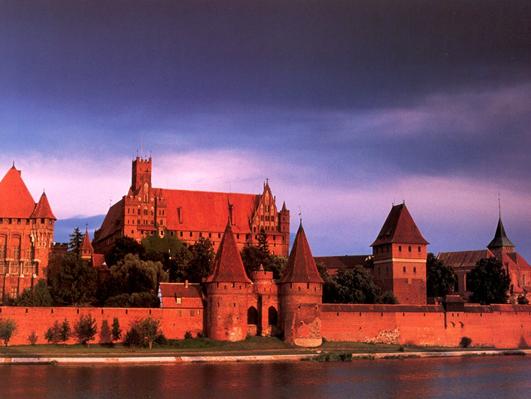
Malbork Castle (12)
Foto: www.poland.gov.pl
To the east of Pomerania spreads the Mazury Lake District, a huge, thinly populated area of lakes, dense forests and swamps, often named "a land of a thousand lakes"; however, the real number of lakes is about four thousand. It is rich in wildlife, including wild bison and Europe’s largest herd of elks, and provides every form of outdoor activity – sailing, canoeing and camping. Most lakes are linked by rivers and canals, the main tourist attractions of which are the Augustow and Elblag canals, the latter being a masterpiece of the 19th century Prussian engineering. The heart of the Mazurian forest in Ketrzyn hides the Hitler’s ‘Eagle’s Nest’, a concrete bunker, where an attempt to assassinate Hitler took place.
To the southeast of this lake district extends the Bialowieza National Park, an area of
probably the only intact primal forest in Europe, which serves as the reserve of European bison. In addition to extraordinary wildlife, one can also admire orthodox churches and two surviving Tartar mosques.
The medieval walled town of Torun, a UNESCO World Heritage Site with the striking Gothic Town Hall, is the birthplace of the astronomer Copernicus. Poznan , is the serene provincial capital with interesting sights such as the Italianate Town Hall in the Old Market Square, the Gorki Palace, the 12th-century Church of St John and Przemyslaw Castle. The National Museum stores one of the country’s few displays of old master paintings. The Poznan International Trade Fair takes place here every year.
The modern city of Wroclaw is cut through with 90km of canals and tributaries of the River Oder and there are more than 100 bridges. The city boasts a very large Old Town with 15th-century Town Hall, the Royal Palace; and the Cathedral built on 7 islands.
To the southeast of the capital lies a charming medieval university city of Lublin, which shelters many buildings designed by Bernardo Morando of Padua, and by many Armenians and Greeks who once settled down here. Not far from Lublin a unique artistic town of Kazimierz Dolny is situated, with its a romantic castle ruin, Baroque churches, winding streets and unspoiled atmosphere is a top attraction of Poland. Another interesting site is Zamosc with its well preserved Academy, beautiful tenement houses and fortification walls. The unique site was founded in the 16th century by the chancellor Jan Zamoysky as a town in ideal shape. It has preserved the original layout and a large number of buildings that feature Italian and central European architectural traditions. Its Old Town has been acknowledged a UNESCO World Heritage status.
The vast historical and ethnographic region in southeastern Poland-Lesser Poland (Malopolska) - is the hub of Polish tourism. The capital of this region Krakow
is the most celebrated and beloved Poland's city with its Renaissance allure and plentiful of sights such as the largest old town square in Europe, the Cloth Hall, Wawel Castle, Gothic art masterpieces, the medieval site of Kazimierz with its ancient synagogues, numerous historical houses, palaces and churches with their magnificent interiors, Jagellonian University, man-made hills, a bugle call every hour and many other unforgettable attractions. Close to Krakow there are two of Poland’s UNESCO World Heritage Sites, the cathedral-like salt mine at Wieliczka and the greatest Nazi extermination camp in Auschwitz. Moreover, Wadowice, the birthplace of Pope John Paul II is situated in the area as well as Kalwaria Zebrzydowska a beautiful pilgrimage site, a UNESCO landmark. Other important nearby spots include the Bledowska Desert, which appears to be the only true desert in Europe and the Icon of the Black Madonna in the enormous Jasna Gora monastery complex at Czestochowa.
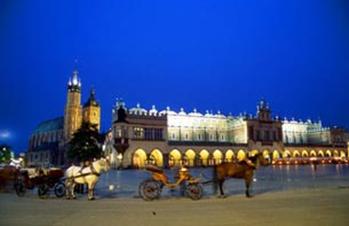
Market Square in Krakow. Photo: P. Kubisztal www.poland.gov.pl (13)
With high peaks for climbing, outstanding views of the mountain scenery, first-rate trails, winters sports facilities and folklore, the Polish part of the Carpathians attract many tourist every season. The centre of this region is Zakopane having an extraordinary atmosphere due to its location at the foothills of the granite mountains, its wooden cottages and many inhabitants who still wear national dress. There are four National Parks within the Tatras: Babiogorski, Gorczanski, Pieninski (with the beautiful mountain gorge of the River Dunajec) and Tatrzanski. In the southeast there is another popular tourist destination – the Bieszczady Mountains, some parts of which still remain wild and intact by humans. There are 11 nature reserves in Bieszczady. Sanok, the biggest town in this region, houses a famous open air museum with an ethnographic exposition of Polish – Ukrainian borderland presenting wooden buildings from the 17th to the 20th century. There is also one of the oldest artificial lakes in Poland – Zalew Solinski - providing sailing and swimming facilities.
The present administrative division of Poland was introduced on January 1st, 1999 due to Jerzy Buzek's government's reorganisation of the administration. Consequently, the number of the provinces called voivodships was reduced from 49 to 16, making them more like regions in other European countries, taking into account their historical background. Furthermore, counties called poviats were brought back to the administration system as an intermediate unit between the commune (gmina) and the voivodeship, and some of the administrative duties and tasks were granted to the territorial authorities. There are about 400 poviats in Poland. The smallest administrative units are the communes – gminy.
The major Polish cities are Warsaw, Łodz, Cracow (Krakow), Wrocław, Poznan, Gdansk, Szczecin, Bydgoszcz, Katowice, and Lublin. The main historical regions are Pomerania (Pomorze), Masuria (Mazury), Greater Poland (Wielkopolska), Mazovia (Mazowsze), Podlassia (Podlasie), Silesia (Slask), Lesser Poland (Malopolska), and Sub-Carpathia (Podkarpacie). Moreover, since 1990 16 Euroregions have been created along Poland's borders. These trans-border regional entities embrace the Pomeranian Euroregion ( Poland, Germany, and Sweden), the Neisse Euroregion ( Poland, Czech Republic, and Germany) and the Carpathian Euroregion ( Poland, Ukraine, Hungary, Slovakia, and Rumania).
The Voivodeships of Poland (14)
The Voivodeships of Poland
![]() The Voivodeship of Lower Silesia (wojewodzwto dolnoslaskie) with major cities: Wroclaw, Walbrzych, Legnica, Jelenia Gora, Klodzko
The Voivodeship of Lower Silesia (wojewodzwto dolnoslaskie) with major cities: Wroclaw, Walbrzych, Legnica, Jelenia Gora, Klodzko
![]() The Voivodeship of Cuiavia and Pomerania (wojewodztwo kujawsko-pomorskie) with
The Voivodeship of Cuiavia and Pomerania (wojewodztwo kujawsko-pomorskie) with
major cities: Bydgoszcz, Torun, Wloclawek, Grudziadz, Inowrocław
![]() The Voivodeship of Lublin (wojewodztwo lubelskie) with major cities: Biala Podlaska, Chelm, Lublin, Zamosc
The Voivodeship of Lublin (wojewodztwo lubelskie) with major cities: Biala Podlaska, Chelm, Lublin, Zamosc
![]() The Voivodeship of Lubusz (wojewodzwto lubuskie) with major cities: Gorzow Wielkopolski, Zielona Gora
The Voivodeship of Lubusz (wojewodzwto lubuskie) with major cities: Gorzow Wielkopolski, Zielona Gora
![]() The Voivodeship of Lodz (wojewodzwto łodzkie) with major cities: Lodz, Skierniewice, Sieradz, Piotrkow Trybunalski
The Voivodeship of Lodz (wojewodzwto łodzkie) with major cities: Lodz, Skierniewice, Sieradz, Piotrkow Trybunalski
![]() The Voivodeship of Lesser Poland (wojewodzwto małopolskie) with major cities: Cracow (Krakow), Tarnow, Nowy Sacz
The Voivodeship of Lesser Poland (wojewodzwto małopolskie) with major cities: Cracow (Krakow), Tarnow, Nowy Sacz
![]() The Voivodeship of Mazovia (wojewodzwto mazowieckie) with major cities: Warsaw (Warszawa), Płock, Radom, Siedlce, Ostrołeka
The Voivodeship of Mazovia (wojewodzwto mazowieckie) with major cities: Warsaw (Warszawa), Płock, Radom, Siedlce, Ostrołeka
![]() The Voivodeship of Opole (wojewodzwto opolskie) with major cities: Opole, Kedzierzyn-Kozle
The Voivodeship of Opole (wojewodzwto opolskie) with major cities: Opole, Kedzierzyn-Kozle
![]() The Voivodeship of Sub-Carpathia (wojewodzwto podkarpackie) with major cities: Rzeszow, Przemysl, Tarnobrzeg, Krosno
The Voivodeship of Sub-Carpathia (wojewodzwto podkarpackie) with major cities: Rzeszow, Przemysl, Tarnobrzeg, Krosno
![]() The Voivodeship of Podlassia (wojewodzwto podlaskie) with major cities: Białystok, Lomza, Suwałki
The Voivodeship of Podlassia (wojewodzwto podlaskie) with major cities: Białystok, Lomza, Suwałki
![]() The Voivodeship of Pomerania (wojewodztwo pomorskie) with major cities: Gdansk, Gdynia, Słupsk
The Voivodeship of Pomerania (wojewodztwo pomorskie) with major cities: Gdansk, Gdynia, Słupsk
![]() The Voivodeship of Silesia (wojewodzwto slaskie) with
The Voivodeship of Silesia (wojewodzwto slaskie) with
major cities: Katowice, Czestochowa, Bielsko-Biała
![]() The Voivodeship of Kielce (wojewodzwto swietokrzyskie) with
The Voivodeship of Kielce (wojewodzwto swietokrzyskie) with
major cities: Kielce, Skarżysko-Kamienna, Starachowice, Sandomierz
![]() The Voivodeship of Varmia and Masuria wojewodzwto warminsko-mazurskie) with
The Voivodeship of Varmia and Masuria wojewodzwto warminsko-mazurskie) with
major cities: Olsztyn, Elblag
![]() The Voivodeship of Greater Poland (wojewodzwto wielkopolskie) with major cities: Poznan, Leszno, Kalisz, Pila
The Voivodeship of Greater Poland (wojewodzwto wielkopolskie) with major cities: Poznan, Leszno, Kalisz, Pila
Poland 's population stands at approximately 38,635,144 (July 2005 est.) with an average population density of 123 persons per km 2. This figure makes it the 29th most populated country in the world and the 8th in Europe. 62% of Poles live in cities, which are mainly small or medium sized towns, and half of the population lives in 42 cities of over 100.000 inhabitants, while 38.6% of Poles inhabit rural areas. The main population concentrations are the industrial agglomerations of Katowice (about 4 million people), Warsaw (about 2.5 million), Gdansk and Poznan (about 1.5 million each). The least peopled areas are the north-east and north-west farmlands. As far as gender distribution is concerned, in 2001 females made up 51.4% of Poland's total population while males accounted for 48.6%, so for every hundred men there were 106 women. Population growth rate stands at 0.02%. Recently life expectancy in Poland has been increasing steadily and the forecasts for the future are optimistic. For men, this rate is calculated to rise from the current 69 years to 74 years in 2025, while for women, from 78 to 81 years. Although Polish society is not young, it cannot be called old. An average Pole is about 36 years old. 16.7% percent of Poles are below 14, 70.3 % percent are within the 15-64 range and 65 years and over equals 13 % (2005 est.). The birth rate accounts for 10.78 births/1,000 population (2005 est.) while the death rate equals 10.01 deaths/1,000 population (2005 est.). Infant Mortality Rate-total: 8.51 deaths/1,000 live births. The total fertility rate stands at 1.39 children born/woman (2005 est.).
Warsaw, the capital and Polish largest city has a population of 1,6 million people. Apart from the capital, the Polish largest cities are Łodz, Cracow, Wroclaw, Poznan and a conurbation: Gdansk-Sopot-Gdynia, with the population of about 3,6 million people. From the ethnic point of view, Poland is one of the most homogeneous countries in Europe, because the majority of Poland's people (almost 96.7 %) are of Polish origin. The remainder are of either German 0.4%, Ukrainian 0.1%, Belorussian 0.1%, of other including Jewish descent 2.7% (2002) . Religions present in Poland include Roman Catholicism 95% (about 75% practicing), Roman Catholic Eastern Orthodox, Protestant, and other 5%. The population of Polish communities abroad is estimated at 12 million, with the largest communities living in the USA (5,6 million), Commonwealth of the Independent States (2,5 million), France (1 million), Germany (0,8 million), Canada (0,4 million), Brazil (0,2 million). Net migration rate for Poland is -0.49 migrant(s)/1,000 population (2005 est.). Official language spoken is Polish, belonging to West Slavic Language Group. English is widely spoken in the cities and is the principal foreign language taught in Polish schools. Taking into account the geographical position of the country, German and Russian are frequently spoken. Russian is mainly understood by those over 35.
Literacy of total population is 99.8%.
Chart of age structure in Poland (15)